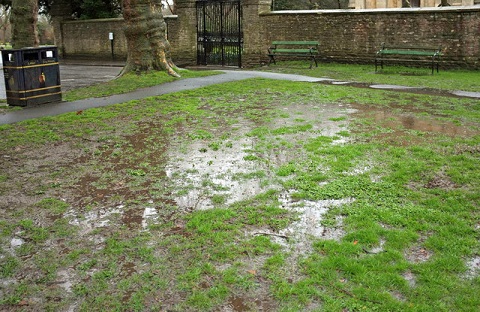If there’s one thing that us Brits know what to deal with, it’s rain, rain and more rain.

Waterlogging, Redland Green by Derek Harper is licensed under CC BY-SA 2.0
Unfortunately for us, we are more than used to our fair share of the wet stuff, so have become accustomed to working and living through it, especially our lawns. This often results in puddles and damp patches, known as waterlogging, that prevent us from taking part in our favourite garden past times, sports or simply enjoying the outdoors.
What causes a waterlogged lawn?
Waterlogged lawns occur when water builds up as a result of excessive rain and is unable to drain away or dry up, which can present a number of problems. Firstly, the presence of water itself can inhibit the supply of oxygen to the grassroots, which in turn can impact the health of the lawn. Second, waterlogged lawns can prevent carbon dioxide in the air from diffusing. The functionality of the grassroots is decreased or halted completely as they start to diminish, which allows the invasion of rot and decay organisms to take place. Thirdly, essential nutrients found within the lawn can be leached out which results in hungry, deprived soil as well as serious compaction. The lawn itself can also thin out, creating an environment where thatch and moss will pitch-in to the new gaps and thrive in the damper conditions.
Preventing a waterlogged lawn
To prevent your lawn from becoming waterlogged in the event of a severe downpour, there are a number of steps that you can take. The main method of prevention, however, is to regularly aerate your lawn. This allows plenty of drainages and air to reach deep into the soil. The best form of aeration for this type of work is known as ‘hollow tine aeration’ as this creates optimum airflow and drainage to the lower levels of soil. Once the lawn has been aerated, you can then re-seed to allow seeds the opportunity to germinate and create a thicker, more complex root system.
It’s important to observe your lawn during patches of rain in order to identify problem areas. These may occur as a result of uneven patches where the water has nowhere to drain. To counter this, be sure to level out uneven patches and aerate to prevent waterlogging from happening.
Dealing with a waterlogged lawn
- Short-term solutions – If your waterlogged lawn was caused by flooding, the first things you can do to rectify it is to wash down hard surfaces and pick up debris to prevent drains from being blocked, allowing a steady flow of water to remove pollutants. Try to avoid stepping on the soil, as doing so will compact the lawn and make the conditions worse. Remove any damaged shoots from affected grass plants. If the waterlogging has occurred during the spring, you can apply a balanced fertiliser to improve growth.
- Long-term solutions – If you have serious waterlogged lawns, we suggest you try to improve the soil structure and drainage system. The most popular drainage systems are known as land drains and French drains. Both of these consist of a trench or series of trenches that are dug into the lawn and lined with a porous film. The trench is then filled with graded stone before being topped off with topsoil so that the relaid turf on the surface returns to being level and even with the rest of the lawn.
The difference between the two types of drains is that a land drain also has a pipe which is often perforated, attached along its length to transport excess water away faster and more efficiently. In both cases, the trenches are dug at a shallow angle in order for the water to flow along the trench by gravity to a strategically-placed soakaway. From here, it is guided to disperse harmlessly underground. The purpose of the porous film is to filter out silt from any water that is washed into the trench. If this filtration didn’t exist, both types of drains can easily become clogged with silt and become overwhelmed with the water they aim to funnel away.
Are you experiencing a waterlogged lawn? Do you require professional help to even out or aerate your lawn? Be sure to get in touch with the expert lawn care team here at Lawn & Weed Expert today by filling out our lawn survey!
Submit a Lawn Survey >